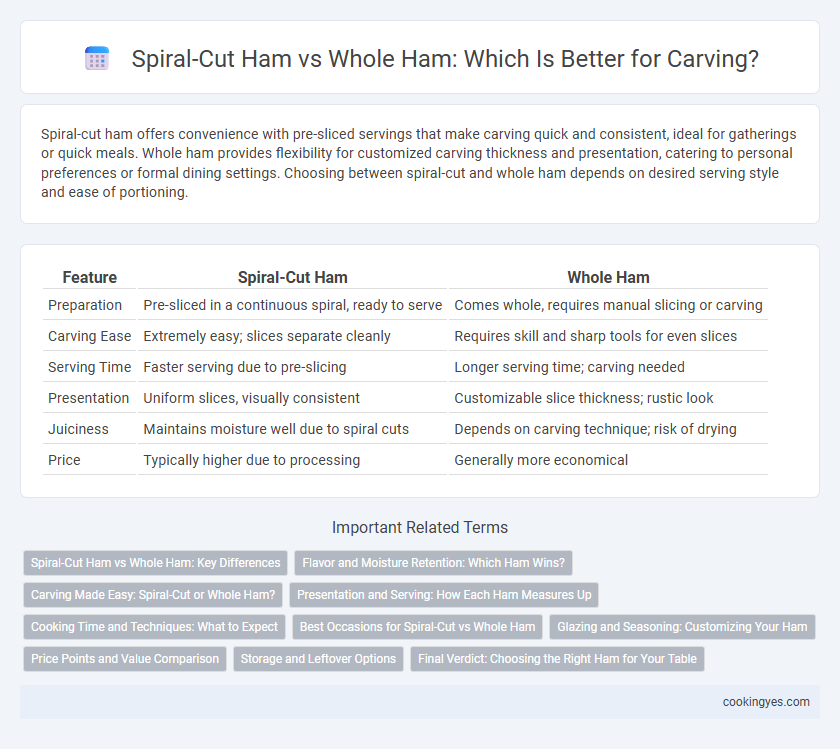Spiral-cut ham offers convenience with pre-sliced servings that make carving quick and consistent, ideal for gatherings or quick meals. Whole ham provides flexibility for customized carving thickness and presentation, catering to personal preferences or formal dining settings. Choosing between spiral-cut and whole ham depends on desired serving style and ease of portioning.
Table of Comparison
| Feature | Spiral-Cut Ham | Whole Ham |
|---|---|---|
| Preparation | Pre-sliced in a continuous spiral, ready to serve | Comes whole, requires manual slicing or carving |
| Carving Ease | Extremely easy; slices separate cleanly | Requires skill and sharp tools for even slices |
| Serving Time | Faster serving due to pre-slicing | Longer serving time; carving needed |
| Presentation | Uniform slices, visually consistent | Customizable slice thickness; rustic look |
| Juiciness | Maintains moisture well due to spiral cuts | Depends on carving technique; risk of drying |
| Price | Typically higher due to processing | Generally more economical |
Spiral-Cut Ham vs Whole Ham: Key Differences
Spiral-cut ham is pre-sliced in a continuous, uniform manner, making it convenient and time-saving for serving large groups without the need for additional carving skills. Whole ham requires manual carving, allowing for personalized thickness and presentation but demands more effort and precision. The key difference lies in preparation ease and serving style, with spiral-cut offering ready-to-serve convenience and whole ham providing customizable slicing options.
Flavor and Moisture Retention: Which Ham Wins?
Spiral-cut ham provides consistent slices and enhanced flavor absorption due to its thin, even cuts that allow glazes to penetrate deeply, resulting in a juicy, flavorful experience. Whole ham retains moisture better during cooking, preserving tenderness and succulence, but may require careful carving to maintain those qualities in each serving. For optimal flavor and moisture retention, spiral-cut ham excels in immediate taste impact, while whole ham offers superior moisture preservation throughout cooking.
Carving Made Easy: Spiral-Cut or Whole Ham?
Spiral-cut ham offers effortless carving with pre-sliced, uniform pieces that reduce preparation time and minimize slicing mistakes. Whole ham requires skill to carve evenly but provides the flexibility to create slices of varying thickness according to preference. Choosing between spiral-cut and whole ham depends on whether convenience or customization is the priority for your meal presentation.
Presentation and Serving: How Each Ham Measures Up
Spiral-cut ham offers uniform, pre-sliced servings that enhance presentation with consistent thickness, making it ideal for quick, elegant plating. Whole ham allows for customized slicing thickness, showcasing a rustic, traditional appearance that can impress guests with carving skills. Both hams provide versatile serving options, but spiral-cut ensures efficiency while whole ham emphasizes visual appeal and carving experience.
Cooking Time and Techniques: What to Expect
Spiral-cut ham requires less cooking time because it is pre-sliced, allowing heat to penetrate quickly and evenly during reheating, making it ideal for quick meal preparation. Whole ham demands longer cooking periods and more precise techniques such as slow roasting or baking to ensure the interior reaches a safe temperature while maintaining moisture and tenderness. Carving whole ham involves slicing thicker sections by hand, offering a fresher texture, whereas spiral-cut ham is ready-to-serve with uniform slices that simplify serving but limit carving customization.
Best Occasions for Spiral-Cut vs Whole Ham
Spiral-cut ham is ideal for large gatherings and casual events due to its easy-to-serve pre-sliced design, perfect for buffets and family meals. Whole ham suits formal occasions and holiday dinners where presentation and custom slicing add elegance to the dining experience. Choosing spiral-cut or whole ham depends on event size, serving style, and desired visual impact.
Glazing and Seasoning: Customizing Your Ham
Spiral-cut ham offers even glazing and seasoning absorption due to its pre-sliced structure, allowing flavors to penetrate each slice uniformly. Whole ham requires scoring and careful brushing to ensure the glaze and seasonings permeate deeply during roasting, enhancing overall taste. Choosing between spiral-cut and whole ham depends on the desired presentation and the level of customization in flavor application.
Price Points and Value Comparison
Spiral-cut ham often comes pre-sliced, offering convenience at a slightly higher price point compared to a whole ham, which typically provides more meat per dollar. Whole ham requires manual carving but delivers better value for large gatherings or multiple meals. Purchasing whole ham allows for customized slice thickness, maximizing yield and cost efficiency.
Storage and Leftover Options
Spiral-cut ham offers convenience with pre-sliced portions that are easier to store and reheat, minimizing waste and maintaining flavor. Whole ham requires more space for storage but allows for flexible slicing thickness, ideal for customizing leftovers in various recipes. Both options benefit from refrigeration and can be frozen, but vacuum-sealed spiral-cut ham typically has a longer shelf life and preserves moisture better.
Final Verdict: Choosing the Right Ham for Your Table
Spiral-cut ham offers convenience with pre-sliced, evenly portioned servings perfect for quick plating and consistent texture. Whole ham provides flexibility in carving thickness and presentation, allowing for customized slices tailored to guest preferences. Selecting the right ham depends on your need for speed versus control in serving, ensuring an optimal dining experience.
Spiral-cut ham vs Whole ham for carving Infographic

 cookingyes.com
cookingyes.com